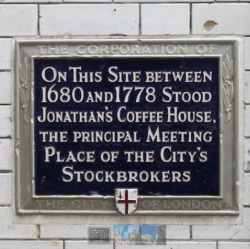Jul
2023
Tradition and innovation can rub shoulders
DIY Investor
27 July 2023
 Innovation is borne out of adversity. Countless technological breakthroughs – including radar, jet engines, and nuclear power – emerged from research conducted during wartime – by Richard Latter
Innovation is borne out of adversity. Countless technological breakthroughs – including radar, jet engines, and nuclear power – emerged from research conducted during wartime – by Richard Latter
In turbulent times, the appetite for innovation, and the desire simply to change things for the better, is particularly high, but the rate of adoption can often be slow. Nowhere is this uneasy relationship between tradition and innovation more apparent than within the investment industry.
The concept of owning shares in publicly-traded companies – via specific stock ‘markets’ – can be traced back to the 1600s. For centuries, buying and selling shares in the UK was the preserve of wealthy individuals and the ‘merchant classes,’ as well as early institutional investors. As more companies issued shares and stock markets evolved, investing became more accessible to a broader number of investors. But you must fast-forward to the 1980s to when investing truly became widespread.
Big Bang theory
In 1986, the ‘Big Bang’ removed some of the restrictions and barriers to investing that had been in place for generations. One of the biggest changes was the introduction of electronic trading systems which revolutionised the process of buying and selling shares. Electronic trading has increased speed, efficiency, and transparency in the markets. While share certificates still exist, most UK shares are now held in dematerialised form and are settled in CREST, a UK-based central securities depository. We have come a long way since investors had to rely on their high street bank or a full-service stockbroker firm to execute trades. Overall, the advent of electronic trading has helped make investing more accessible, efficient, and global.
Online brokers and real-time data
Today, individuals can open online share accounts within minutes and trade shares directly through user-friendly platforms such as Hargreaves Lansdown, AJ Bell, and Interactive Investor. These online platforms give investors all the information they need to make informed decisions allowing them to access a wide range of stocks, track real-time market data, view research and analysis, and execute trades directly through these platforms. These options also, increasingly give investors the option to hold their shares portfolio within stocks and shares ISAs and/or SIPPs.
 Innovative, newer entrant Primary Bid compliments these online platforms, giving all investors fair access to initial public offerings (IPOs) and public company fundraises, at the same time and price as institutional investors.
Innovative, newer entrant Primary Bid compliments these online platforms, giving all investors fair access to initial public offerings (IPOs) and public company fundraises, at the same time and price as institutional investors.
Platforms also now offer a range of enhanced features for investors including dividend reinvestment plans, stock screening tools – including basing investment decisions on environmental, social and governance (ESG) criteria. These platforms also give their clients the opportunity to apply for shares in IPOs alongside institutional investors. Clients can express their interest and submit applications for shares through the platform, and if successful, they are allocated shares at the IPO price. The critical aspect of this innovation is that it makes investing in a range of different asset classes a far more democratised process, removing the traditional barriers to entry that left many individual investors ‘shut out’ from investments like commercial real estate.
Owning property in the future – The multiple applications of Blockchain
The idea of commercial real estate investment via a regulated property stock exchange would have been unheard of in the past. But blockchain can enable ‘fractional ownership’ of commercial real estate assets, allowing investors to own a portion of a property rather than having to pay the full purchase price. This fractional ownership model lowers the entry barrier and further enables smaller-scale investors to participate in commercial real estate investments (in the same way that they can with IPSX) which were previously inaccessible due to the prohibitive costs of buying outright.
Importantly, blockchain also offers a transparent and indisputable ledger where transactional information and ownerships are recorded. All property details, historical records, legal documents, and due diligence reports can be stored on the blockchain, making it accessible to all relevant parties, and no-one else.
What does the future look like?
For a start, paper share certificates will soon become outdated. The Digitisation Taskforce, chaired by Sir Douglas Flint, is driving forward the modernisation of the UK’s shareholding framework and aiming to end the use of paper share certificates, 30 years after the first attempts to do so. Estimates of the number of certificates held vary from 8.6 million to 10 million, about half of which are in the same five companies. Eliminating certificates would save issuers millions of pounds per year, as well as the obvious environmental benefits.
Technology also has a role to play in helping us tackle the climate crisis. The UK has a substantial number of ageing and energy-inefficient buildings, and newly introduced regulations will go some way to making UK buildings more energy-efficient. Refurbs will be expensive, but through IPSX, the world’s first regulated property trading exchange, building owners can sell a percentage of the building’s equity to fund refurbishment and upgrade costs, using the latest innovations in engineering and sustainable building materials.
It will not be too long before the technology you have been reading about in the media becomes a reality for commercial real estate investors – helping them to gain a better understanding of a what a property is used for, where it is located, and the reasons for its valuation. We expect all commercial real estate investors will soon be using products like Apple’s recently launched ‘Vision Pro’ headset to take a virtual tour of any building they are considering buying shares in.
Instead of the days when only the big investment managers had access to a company’s senior management, very soon investors will be able to sit in a virtual room alongside a chairperson, CEO or CFO and ask the questions that matter to them. Technology will have other useful applications too. You could take a walk around a proposed new development, visualising what it will look like when completed. You will be able to find buildings with a barcode or QR code that can be used to download investment details or even an IPO prospectus. These are current innovations that will soon be applied to investing in commercial property.
IPSX: blending innovation with a traditional asset class
Innovation takes many forms. Some of the most effective examples are those that provide a unique way to accomplish what is already considered a trusted concept. IPSX offers a new way to participate in one of the oldest and most traditional asset classes there is – commercial real estate.
Richard Latter is Director of Distribution at IPSX, the world’s first regulated stock exchange dedicated to trading commercial real estate.
Alternative investments Commentary » Alternative investments Latest » Brokers Commentary » Brokers Latest » Commentary » Latest
Leave a Reply
You must be logged in to post a comment.